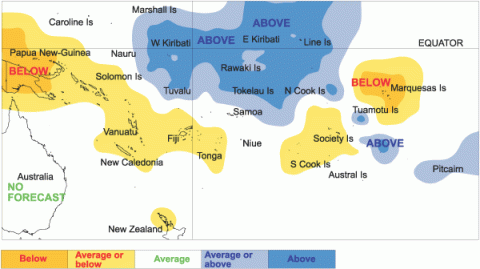Tropical rainfall outlook: December 2004 to February 2005
The atmosphere is yet to fully couple with the tropical ocean. However, it is highly likely that the current weak El Niño event will still have some influence on rainfall patterns in the tropical Pacific region.
Rainfall is expected to be above average in the equatorial region of Western and Eastern Kiribati, extending south to include Tuvalu, Tokelau, and the Northern Cook Islands. Above average or near average rainfall is forecast for Pitcairn Island. Suppressed convection is expected over the Solomon Islands, extending southeast to the Southern Cook Islands, including Vanuatu, New Caledonia, and Tonga, where rainfall is expected to be near average or below.
Below average rainfall is forecast for Papua New Guinea and the Marquesas Islands. Rainfall is expected to be near average elsewhere in the region.
The Pacific seasonal rainfall model skill is moderate for most islands.
Rainfall outlook map for December 2004 to February 2005

Probabilities of rainfall departures from average
Broad-scale rainfall patterns and anomalies in the southern tropical Pacific area are estimated from the state of large-scale regional climate factors, such as La Niña or El Niño, their effect on the South Pacific and Tropical Convergence Zones, surface and sub-surface sea temperatures, and computer models of the global climate.
Rainfall estimates for the next three months for Pacific Islands are given in the adjacent table. The tercile probabilities (e.g. 20:30:50) are derived from the interpretation of several global climate models. They correspond to the odds of the observed rainfall being in the lowest (driest) one third of the rainfall distribution, the middle one third, or the highest (wettest) one third of the distribution. On the long-term average, rainfall is equally likely (33% chance) in any tercile.
The probabilities shown express the expected shift in the distribution from the long-term average, based on predictions of oceanic and atmospheric conditions. The amount of inter-model forecast consistency is indicated by the levels of confidence expressed in the table.
| Island group | Rainfall outlook | Outlook confidence |
|---|---|---|
| Western Kiribati | 25:30:45 (Above) | Moderate |
| Eastern Kiribati | 25:30:45 (Above) | Moderate |
| Tuvalu | 25:30:45 (Above) | Moderate |
| Tokelau | 25:25:50 (Above) | Moderate |
| Northern Cook Islands | 20:30:50 (Above) | Moderate |
| Pitcairn Island | 20:40:40 (Average or above) | Moderate |
| Wallis and Futuna | 25:45:30 (Near average) | Moderate |
| Samoa | 25:50:25 (Near average) | Moderate |
| Fiji | 30:50:20 (Near average) | Moderate |
| Niue | 25:45:30 (Near average) | Low – Moderate |
| Society Islands | 35:45:20 (Near average) | Low – Moderate |
| Austral Islands | 25:50:25 (Near average) | Moderate |
| Tuamotu Islands | 20:50:30 (Near average) | Moderate |
| Solomon Islands | 45:40:15 (Near average or below) | Moderate |
| Vanuatu | 40:45:15 (Near average or below) | Moderate |
| New Caledonia | 45:40:15 (Near average or below) | Moderate |
| Tonga | 40:40:20 (Near average or below) | Low |
| Southern Cook Islands | 35:40:25 (Near average or below) | Moderate |
| Papua New Guinea | 50:30:20 (Below) | Moderate |
| Marquesas Islands | 45:35:20 (Below) | Low |
Rainfall outcomes as estimated from models and historical records. The third column indicates the probability of bottom (below), middle (average) or top (above) tercile rainfall, where a percentage is given. The rainfall outlook (second column) is subjectively estimated from the probabilities of bottom, middle and top terciles.
